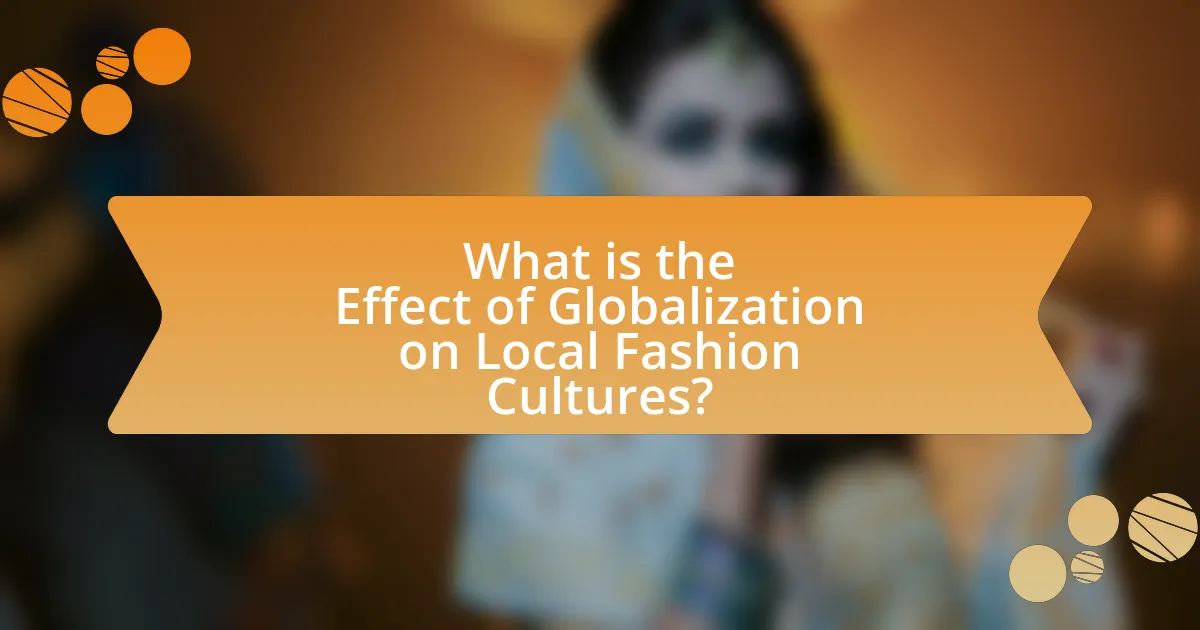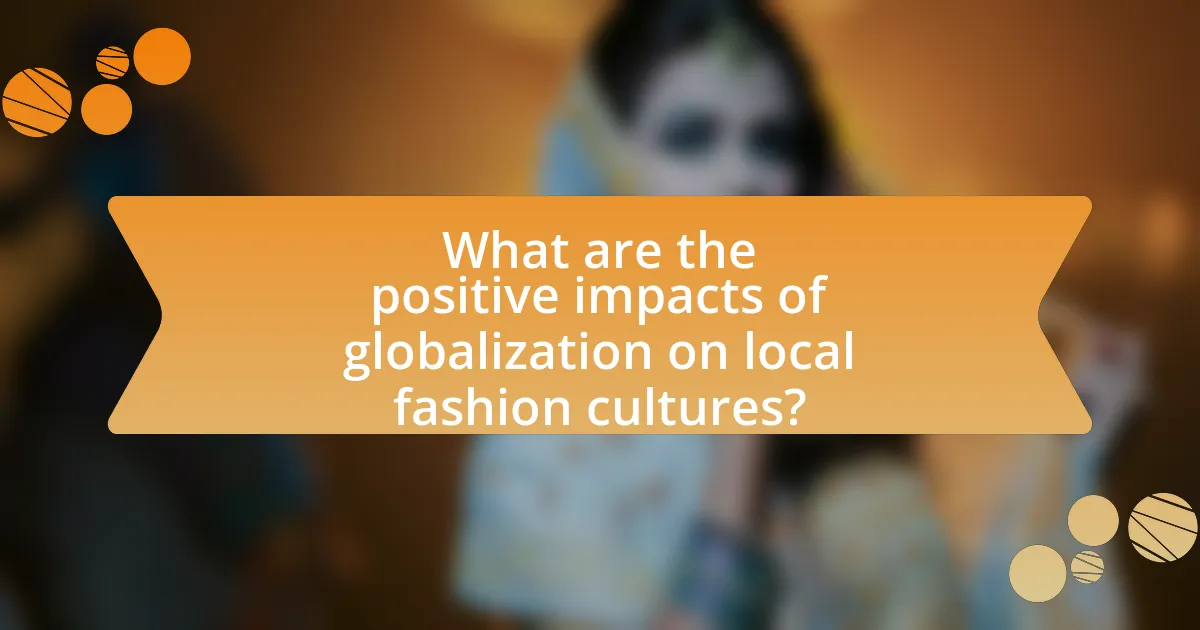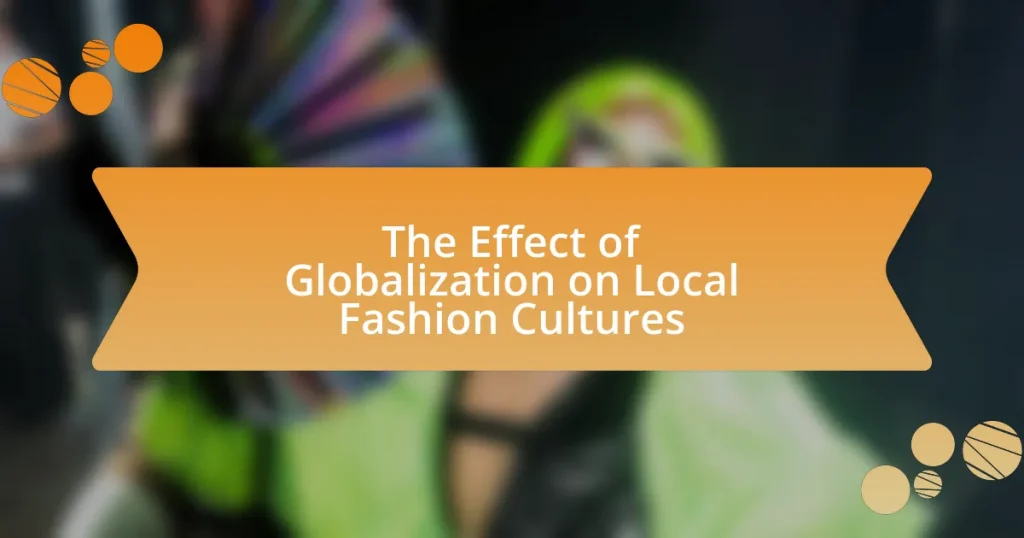The article examines the effect of globalization on local fashion cultures, highlighting how the exchange of styles, materials, and trends across borders influences local identities. It discusses the dual impact of globalization, which can enhance creativity and market access for local designers while also threatening traditional craftsmanship and leading to homogenization of fashion. Key factors driving this phenomenon include technological advancements, cultural exchange, and economic integration. The article further explores the implications for local artisans, the challenges they face, and strategies to preserve unique fashion identities in a globalized context.

What is the Effect of Globalization on Local Fashion Cultures?
Globalization significantly influences local fashion cultures by promoting the exchange of styles, materials, and trends across borders. This interaction often leads to the homogenization of fashion, where local identities may be diluted as global brands dominate the market. For instance, the rise of fast fashion retailers like Zara and H&M has made Western styles widely accessible, impacting traditional clothing practices in various regions. Additionally, a study by the International Journal of Fashion Studies highlights that while globalization can enhance creativity by introducing diverse influences, it can also threaten the sustainability of local artisans and traditional craftsmanship, as mass-produced items overshadow unique local designs.
How does globalization influence local fashion trends?
Globalization influences local fashion trends by facilitating the exchange of styles, materials, and cultural influences across borders. This interconnectedness allows local designers to access global fashion markets and trends, leading to the incorporation of international styles into local wardrobes. For instance, the rise of fast fashion brands, such as Zara and H&M, has made global trends more accessible, prompting local consumers to adopt these styles. Additionally, social media platforms enable the rapid dissemination of fashion trends worldwide, allowing local fashion scenes to adapt and evolve in response to global influences. This phenomenon is evident in cities like Tokyo and New York, where local fashion is often a blend of traditional elements and contemporary global styles, reflecting a hybridization of cultural influences.
What are the key factors driving the globalization of fashion?
The key factors driving the globalization of fashion include technological advancements, cultural exchange, and economic integration. Technological advancements, particularly in communication and transportation, have enabled brands to reach global markets efficiently. For instance, the rise of e-commerce platforms allows consumers worldwide to access diverse fashion products. Cultural exchange occurs through social media and international travel, where trends and styles are shared and adopted across borders. Economic integration, characterized by trade agreements and global supply chains, facilitates the movement of goods and services, allowing fashion brands to source materials and labor from various countries, thus enhancing their global presence.
How do international brands impact local fashion identities?
International brands significantly influence local fashion identities by introducing global trends and altering consumer preferences. This impact often leads to a blending of local styles with international aesthetics, resulting in hybrid fashion expressions. For instance, the presence of brands like Zara and H&M in various countries has shifted local fashion dynamics, as these brands offer fast fashion that appeals to local consumers seeking modernity and affordability. Research indicates that in markets such as India and China, international brands have not only increased competition but also encouraged local designers to innovate and adapt, thereby reshaping traditional fashion narratives. This phenomenon illustrates how globalization facilitates a dialogue between local and global fashion, ultimately transforming local identities while also preserving certain cultural elements.
Why is it important to study the effects of globalization on fashion?
Studying the effects of globalization on fashion is important because it reveals how cultural exchanges shape local fashion identities and consumer behaviors. Globalization facilitates the flow of ideas, materials, and trends across borders, leading to hybrid styles that reflect both local traditions and global influences. For instance, the rise of fast fashion brands has transformed local markets, often overshadowing traditional craftsmanship and altering consumer preferences. Research indicates that in countries like India, globalization has led to a blend of Western styles with indigenous textiles, impacting local artisans and fashion industries. Understanding these dynamics is crucial for addressing issues such as cultural appropriation, sustainability, and the preservation of local fashion heritage.
What cultural exchanges occur through global fashion interactions?
Cultural exchanges through global fashion interactions include the blending of traditional attire with contemporary styles, the adoption of diverse fashion trends across different regions, and the sharing of cultural symbols and practices. For instance, the incorporation of African prints in Western fashion demonstrates how local aesthetics influence global trends, while brands like Gucci and Louis Vuitton have integrated elements from various cultures into their collections, showcasing a fusion of global influences. This exchange is further evidenced by events like Fashion Weeks around the world, where designers from different backgrounds present their work, fostering cross-cultural dialogue and appreciation.
How does globalization affect traditional fashion practices?
Globalization significantly influences traditional fashion practices by introducing global trends and mass production techniques that often overshadow local craftsmanship. This shift can lead to the erosion of cultural identities as traditional garments are replaced by standardized, fast fashion items. For instance, the rise of brands like Zara and H&M has resulted in a decline in the demand for handmade clothing, which is integral to many cultures. Additionally, globalization facilitates the spread of Western fashion ideals, often marginalizing indigenous styles and practices. According to a study by the International Journal of Fashion Studies, the homogenization of fashion due to globalization has resulted in a loss of diversity in traditional attire, as local artisans struggle to compete with cheaper, mass-produced alternatives.

What are the positive impacts of globalization on local fashion cultures?
Globalization positively impacts local fashion cultures by facilitating the exchange of ideas, materials, and trends across borders. This exchange allows local designers to incorporate global influences into their work, leading to innovative designs that blend traditional elements with contemporary styles. For instance, the rise of social media platforms has enabled local fashion brands to reach international audiences, increasing their visibility and market potential. Additionally, globalization fosters collaboration between local artisans and global brands, enhancing craftsmanship and promoting sustainable practices. According to a study by the International Journal of Fashion Design, Technology and Education, such collaborations have led to a 30% increase in the income of local artisans in regions where global partnerships are established.
How does globalization promote diversity in fashion?
Globalization promotes diversity in fashion by facilitating the exchange of cultural influences and styles across borders. This interconnectedness allows designers and consumers to access a wider array of fashion trends, materials, and techniques from different cultures. For instance, the rise of fast fashion brands has enabled the incorporation of traditional garments and motifs from various cultures into mainstream fashion, reflecting a blend of global aesthetics. Additionally, events like international fashion weeks showcase diverse designers, highlighting unique cultural narratives and fostering appreciation for different fashion identities. This cross-cultural interaction not only enriches the fashion landscape but also encourages inclusivity and representation within the industry.
What role do social media and technology play in this diversity?
Social media and technology significantly enhance diversity in local fashion cultures by facilitating the exchange of ideas and trends across global platforms. These digital tools enable designers and consumers to access a wide array of styles and influences from different cultures, fostering a more inclusive fashion landscape. For instance, platforms like Instagram and TikTok allow users to showcase their unique fashion interpretations, which can quickly gain traction and inspire others worldwide. According to a report by McKinsey & Company, the rise of digital channels has accelerated the pace of fashion trends, allowing diverse cultural expressions to reach broader audiences faster than ever before. This interconnectedness not only promotes cultural appreciation but also encourages the blending of traditional and contemporary styles, enriching local fashion scenes.
How do collaborations between local and global brands enhance creativity?
Collaborations between local and global brands enhance creativity by merging diverse cultural perspectives and resources. Local brands bring unique insights into regional trends, consumer preferences, and traditional craftsmanship, while global brands contribute broader market knowledge, advanced technology, and extensive distribution networks. This synergy fosters innovative product designs and marketing strategies that resonate with a wider audience. For instance, the collaboration between Nike and local artists in various countries has resulted in culturally inspired sneaker designs that reflect local heritage while maintaining global appeal. Such partnerships not only stimulate creative processes but also promote cross-cultural exchange, leading to fresh ideas and unique offerings in the fashion industry.
What economic benefits arise from globalization in fashion?
Globalization in fashion leads to increased market access and economic growth for brands and manufacturers. By expanding into international markets, fashion companies can tap into a larger consumer base, resulting in higher sales and revenue. For instance, according to a report by McKinsey & Company, the global fashion industry was valued at approximately $2.5 trillion in 2021, showcasing the significant economic impact of globalization. Additionally, globalization facilitates cost reductions through outsourcing production to countries with lower labor costs, which can enhance profit margins for fashion brands. This interconnectedness also fosters innovation and competition, driving efficiency and creativity within the industry.
How does globalization create job opportunities in local fashion industries?
Globalization creates job opportunities in local fashion industries by expanding market access and fostering collaboration with international brands. As local designers gain exposure to global trends and consumer preferences, they can innovate and produce unique products that appeal to a broader audience. This increased demand leads to the establishment of new businesses and the growth of existing ones, resulting in job creation. For instance, a report by the International Labour Organization indicates that the global fashion industry employs over 60 million people, with many local artisans and manufacturers benefiting from international partnerships and supply chains.
What are the implications for local artisans and designers?
Globalization significantly impacts local artisans and designers by increasing competition and altering consumer preferences. As international brands penetrate local markets, artisans face challenges in maintaining their unique cultural identities while competing with mass-produced goods. This shift often leads to a decline in traditional craftsmanship as consumers gravitate towards cheaper, globally available options. Furthermore, globalization can provide local artisans with access to broader markets through online platforms, enabling them to reach a global audience. However, this requires adaptation to global trends, which may dilute their original designs. The balance between preserving cultural heritage and adapting to global demands is crucial for the sustainability of local artisans and designers in a globalized economy.

What are the negative impacts of globalization on local fashion cultures?
Globalization negatively impacts local fashion cultures by promoting homogenization, which leads to the erosion of unique cultural identities. As global brands dominate markets, traditional clothing styles and practices often diminish, replaced by mass-produced, standardized fashion that lacks cultural significance. For instance, a study by the International Journal of Fashion Studies highlights that local artisans struggle to compete with the pricing and marketing power of global brands, resulting in a decline in traditional craftsmanship and local textile industries. This shift not only affects economic sustainability but also threatens the preservation of cultural heritage associated with local fashion practices.
How does globalization lead to the homogenization of fashion?
Globalization leads to the homogenization of fashion by facilitating the widespread dissemination of similar styles and trends across different cultures. This occurs through the global reach of fashion brands, which leverage international supply chains and marketing strategies to promote a unified aesthetic. For instance, major fashion retailers like Zara and H&M produce collections that are available worldwide, often reflecting a blend of Western styles that overshadow local fashion identities. Additionally, the rise of social media platforms enables rapid sharing of fashion trends, further diminishing regional variations as consumers increasingly adopt similar looks influenced by global icons and influencers. This trend is supported by research indicating that global fashion markets are increasingly dominated by a few multinational corporations, which standardize offerings to maximize appeal across diverse consumer bases.
What are the consequences for local craftsmanship and heritage?
Globalization leads to the decline of local craftsmanship and heritage by promoting mass production and homogenization of fashion. As global brands dominate markets, traditional artisans struggle to compete with cheaper, mass-produced alternatives, resulting in a loss of unique cultural expressions and skills. For instance, UNESCO reports that many traditional crafts are at risk of disappearing due to the overwhelming influence of global fashion trends, which prioritize speed and cost over quality and cultural significance. This shift not only threatens the livelihoods of local artisans but also erodes the cultural identity tied to these crafts, diminishing the diversity of global fashion cultures.
How does the dominance of global brands affect consumer choices?
The dominance of global brands significantly influences consumer choices by creating a perception of quality and status associated with these brands. Consumers often gravitate towards well-known global brands due to their extensive marketing, which establishes trust and familiarity. For instance, a study by the Journal of International Marketing found that consumers are more likely to purchase products from brands they recognize, as familiarity reduces perceived risk in purchasing decisions. Additionally, global brands often set trends that local brands may follow, further shaping consumer preferences and behaviors. This trend-setting ability reinforces the dominance of global brands, making them a primary choice for many consumers.
What challenges do local fashion cultures face due to globalization?
Local fashion cultures face significant challenges due to globalization, primarily the dilution of cultural identity. As global brands dominate markets, traditional styles and practices often become overshadowed, leading to a homogenization of fashion that undermines local uniqueness. For instance, a study by the International Journal of Fashion Studies highlights that local artisans struggle to compete with mass-produced items, resulting in a decline in traditional craftsmanship and cultural heritage. Additionally, the influx of global trends can pressure local designers to conform to international standards, further eroding distinct cultural expressions in fashion.
How do economic disparities influence local fashion markets?
Economic disparities significantly influence local fashion markets by determining consumer purchasing power and shaping demand for various fashion products. In affluent areas, consumers tend to favor high-end brands and luxury items, leading to a market that prioritizes exclusivity and premium pricing. Conversely, in economically disadvantaged regions, the focus shifts to affordability and practicality, resulting in a demand for budget-friendly clothing options.
For instance, a study by the McKinsey Global Institute highlights that income inequality affects consumer behavior, with wealthier consumers driving trends towards luxury fashion, while lower-income groups often rely on fast fashion retailers. This disparity creates a bifurcated market where local fashion businesses must adapt their offerings to cater to the economic realities of their target demographics, ultimately influencing the overall fashion landscape in a given area.
What strategies can local designers adopt to compete globally?
Local designers can adopt strategies such as leveraging unique cultural narratives, utilizing digital platforms for global reach, and forming collaborations with international brands to compete globally. By emphasizing their distinct cultural heritage, designers can create products that resonate with consumers seeking authenticity, which is increasingly valued in the global market. The use of digital marketing and e-commerce allows local designers to access a wider audience, as evidenced by the growth of online fashion sales, which reached approximately $759.5 billion in 2021, according to Statista. Collaborations with established international brands can enhance visibility and credibility, providing local designers with opportunities to showcase their work on a larger stage.
What can be done to preserve local fashion cultures in a globalized world?
To preserve local fashion cultures in a globalized world, communities can promote and support local artisans and designers. By prioritizing the purchase of locally made clothing and accessories, consumers can help sustain traditional craftsmanship and cultural heritage. For instance, initiatives like local fashion markets and cultural festivals can showcase indigenous designs and techniques, fostering appreciation and demand for local styles. Additionally, educational programs that teach traditional fashion-making skills can ensure that these practices are passed down to future generations, thereby maintaining cultural identity in the face of globalization.
How can local communities promote their unique fashion identities?
Local communities can promote their unique fashion identities by organizing local fashion events that showcase traditional attire and contemporary designs inspired by local culture. These events, such as fashion shows or markets, provide a platform for local designers and artisans to present their work, fostering community pride and attracting attention from outside the area. For instance, the annual “Fashion Week” in various cities often highlights regional styles, allowing local designers to gain visibility and connect with broader audiences. Additionally, collaborations with local artists and influencers can amplify the reach of these fashion identities, as seen in initiatives like “Fashion for a Cause,” which merges local craftsmanship with social issues, thereby enhancing community engagement and identity.
What role do policy makers play in supporting local fashion industries?
Policy makers play a crucial role in supporting local fashion industries by creating favorable regulations, providing financial incentives, and promoting cultural heritage. They establish policies that encourage sustainable practices and protect local artisans, which helps maintain the unique identity of local fashion amidst globalization. For example, initiatives such as grants for small businesses and tax breaks for local manufacturers can stimulate growth and innovation within the industry. Additionally, policy makers can facilitate access to international markets through trade agreements that favor local products, thereby enhancing the competitiveness of local fashion brands on a global scale.



